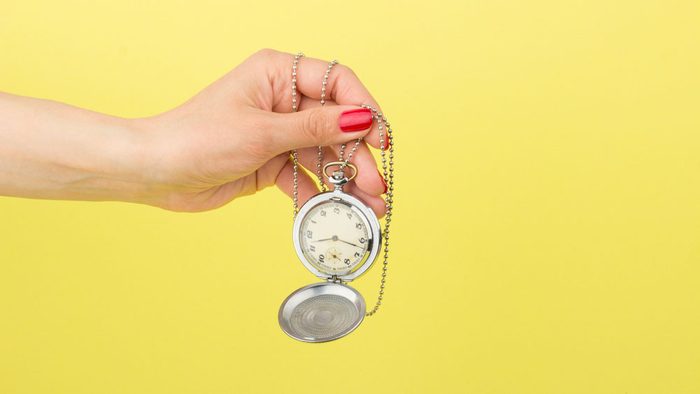
I was wrong about my mole
I always thought I had a pretty good handle on my ABCDs. It was “E” that was the trouble, until I was diagnosed with melanoma.
In December 2015, I was shaving my legs when I noticed a mole on the outside of my left knee. It had been there forever, but it suddenly looked darker than I remembered. And yet it was symmetrical, had an even border, was all one colour and had a small diameter, so I told myself it was fine. I figured I’d get it checked out when things slowed down and I had more time.
The ABCDEs make ups the checklist for moles: Asymmetry, border, colour, diameter and evolution.
When I finally saw my family doctor three months later, she was reassuring. “It’s probably nothing to worry about,” she said. Still, she booked an appointment for me to see a dermatologist just to be safe. It turns out that the “E” I’d forgotten about stands for “evolving” and, when it comes to skin cancer detection, it’s the most important letter of all.
Dr. Lisa Kellett, a Toronto dermatologist, took one look at my mole and did a biopsy right then and there. The results were back within a week: It was stage one malignant melanoma. “You’re a good example of how skin cancer doesn’t always meet the ABCD criteria,” Dr. Kellett told me. “But change, including when a new mole appears, is an important factor to be aware of.”
Skin cancer rates have been rising in Canada for some time now and account for one-third of all new cancers. There are more new cases each year than the number of breast, prostate, lung and colon cancers combined – more than 80,000, to be exact.
The problem is that people aren’t protecting themselves, says Dr. Kellett. One of the biggest myths surrounding the disease is that it only happens to old people (her youngest patient with skin cancer is eight). “Those who are good at sun protection are the ones who already have skin cancer,” she says. “I tell 20-year-olds, ‘Look you have to be more careful or you’ll see the side effects [of photo-aging] in 20 years. However, many state that they won’t care in 20 years how they look. The kicker is that patients in their 40s and 60s say the exact same thing. I tell them all, ‘Trust me, you will care.’”
Keep reading for the unexpected side of skin cancer.
- This article originally appeared in the May 2017 issue of Best Health with the title, “Save your skin.” It’s been nominated for a 2018 National Magazine Award in the category of Service Journalism.

No one is immune to skin cancer
After my biopsy, I needed a second procedure to remove a wider, deeper area of skin to ensure that there were no lingering cancer cells.
When I arrived at the hospital for my appointment, all 80 seats in the skin cancer clinic were full, occupied by people of all ages and backgrounds.
No one, it seems, is immune to skin cancer.
When you’re sitting in a waiting room for hours, you can only spend so much time looking at your phone. Eventually, people started sharing their stories.
I met a man in his 50s who worked in construction and was having a third melanoma removed from his back and a nursing student in her 20s whose mother had died of melanoma – she was having a second mole removed from her chest.
While the two of us were talking, an elegant woman in her 60s told us that she was there to have her vaginal melanoma treated (vaginal melanomas are rare, accounting for no more than two percent of melanomas among women, but they’re one of the reasons why it’s so important to check everywhere).
Between 80 and 90 percent of skin cancers are caused by ultraviolet radiation, but melanoma originates from normal pigment cells called melanocytes and, like any other cell, they can become cancerous. Melanomas are most often found on the chest and back in men and on the legs in women, but they can also appear on the soles of the feet, the palms of the hands and the mouth.
Related: 15 Eczema Causes You Might Be Ignoring
When you talk to people who have been diagnosed with melanoma and other skin cancers, they can often pinpoint lapses in sun safety that may be to blame. I immediately thought about the summers I spent teaching sailing at a girls’ camp in northern Ontario. Wading into the lake to rig a Laser with a group of nine-year-olds meant that any sunscreen – hastily and, let’s face it, often sporadically applied – was washed away before I even set sail.
Although melanoma is the most dangerous skin cancer diagnosis you can get, people often tend to be too dismissive when they develop other kinds, says Dr. Robert Nuttall, assistant director of health policy at the Canadian Cancer Society. “People will say, ‘Oh, I just had a spot removed as a precaution,’ and they don’t make the connection to cancer,” he says. “You have to think about your history of time spent in the sun and be vigilant about any sign of change on your skin.” Whether it’s a precancerous spot or a misshapen mole, the faster you act, the better the outcome. Report any changes on your skin to your doctor.

Hurry up and wait
Although a faster diagnosis does lead to faster treatment, most Canadians don’t realize that there are gaps in care when it comes to skin cancer.
In 2015, a year after her husband died, Linda Thiessen finally saw a dermatologist and was diagnosed with her 14th basal cell carcinoma. Because it had gone unchecked for so long, removing the spot with liquid nitrogen was no longer an option. Thiessen, a 63-year-old from Coquitlam, BC, needed Mohs surgery but learned that there are only 20 doctors who perform the procedure in Canada.
Mohs is used to identify and remove a tumour one layer at a time, without harming the healthy tissue surrounding it, and is used to treat basal and squamous cell cancers, as well as some melanomas. It’s considered an improvement over standard surgery, or excision, which involves removing the visible cancer and a small margin of surrounding healthy tissue all at once and waiting for the results. Mohs reduces the need for additional surgery and increases the chances that the cancer will be cured. The problem is getting it when you need it.
To avoid the nine-month waiting list in British Columbia, Thiessen booked a plane ticket to Edmonton, where Dr. Mariusz Sapijaszko, medical director of the Western Canada Dermatology Institute and Youthful Image Clinic, performed her surgery last fall. She is now waiting for the second of two revision surgeries to improve function around her eye.
“Instead of four or five stitches, I had massive surgery,” she says. “I hadn’t even looked in the mirror that morning to say goodbye to my familiar face.” Dr. Sapijaszko explained that her cancer had grown like an octopus under the surface of her skin. It took six tissue removals, in ever-widening circles, until he was able to get clear tissue.
Thiessen says she’s just happy she was able to get the procedure, even if she had to go out of province. “I’m grateful that Dr. Sapijaszko was able to remove it all.

On your birthday, check your birthday suit
Dr. Marcie Ulmer, a board-certified medical and cosmetic dermatologist at Pacific Dermaesthetics in Vancouver, recommends checking your birthday suit on the calendar date of your birthday every month. If your birthday is
“Skin cancer is the most detectable because it occurs on an organ we can see, unlike other types of cancers, such as the liver, lungs and ovaries,” she says, “and it’s highly curable if caught early.”
The longer skin cancer goes undiagnosed, the more invasive the treatment, which is why diagnosis and prevention are so important. “Know your body,” says Dr. Sapijaszko. “If something is different and doesn’t go away in a month or two, ask your doctor ‘Is this normal?’”
He adds that the majority of skin cancers are found by patients and family members. “We’re good at diagnosing cancer, but our patients are the ones who find it.”
But most important, she says, is prevention. Dr. Ulmer says people still frequent tanning salons to get vitamin D (you can get all you need from reasonable sun exposure during a short walk, food and supplements) or a base tan before a vacation (a base tan gives you an SPF of 4 at most – and increases your risk of cancer in the process). “Skin cancer is one of the most preventable types of cancer, and it’s never too late, even for former sun worshippers,” she says. “Sun damage is cumulative, so you need to stop accumulating damage. You can’t change the past, but you can change your behaviour.”
Related: How Your Beauty Products Could Be Sabotaging Your Fertility
In 2012, Sophie Belanger had what had looked like a pimple – but was actually basal cell cancer – removed from under her left eye. “I don’t remember my mom ever putting sunscreen on me,” says the 45-year-old businesswoman from Calgary. “We just didn’t know any better back then.” She has two teenage daughters for whom sun protection is now a habit. “They saw me with a bandage over my eye and it’s just part of their lifestyle now,” says Belanger. “When they play soccer, sunscreen is part of their equipment.”
Keep reading to learn about how you can protect yourself.

The right way to protect yourself
Unfortunately, not all sunscreens are created equal, says Dr. Ken Alanen, a dermatologist, dermatopathologist and Mohs skin cancer surgeon in Calgary. An unfortunate fact I learned after I was diagnosed with melanoma.
Anything beyond SPF 30 (SPF – what we use to measure a product’s sun-protective powers) is a marketing tool, he says. “An SPF of 40 gives you 98 percent protection – anything higher doesn’t make a difference,” he adds.
Also, SPF mostly protects against UVB filtration (five percent of UV rays), not UVA filtration (95 percent of UV rays). “UVB is what burns you,” he says. “Back when we thought a high SPF mattered, people would say ‘Hey, I’m not burning’ and stay out longer, basically roasting themselves and the DNA in their skin. Now, we know different: Tanning is not safe; there is no such thing as a healthy tan.”
Finally, don’t rely on moisturizer or makeup for sun protection.
Dr. Alanen says that the U.S. Food and Drug Administration is proposing new guidelines that won’t allow sun protection claims on moisturizers and makeup in the United States.
I pulled out my favourite foundation and ran the ingredients by Dr. Alanen: five percent titanium dioxide and five percent zinc oxide.
“Titanium doesn’t block enough UVA, and neither concentration of five percent is enough,” he told me. “The product is likely cosmetically agreeable but of dubious clinical benefit.”
So much for my favourite “sunscreen.”
What Dr. Alanen does recommend, though, is zinc. “Zinc is natural – it’s basically ground-up rock – and blocks out the entire range of UV light. It’s the longest-lasting as well – chemical sunscreens can only absorb so much UV light before they start to break down.” He says the ideal sunscreen contains at least 20 percent zinc.
Investing in a new sunscreen is just one of the changes I’ve made since my diagnosis over a year ago.
Since I was diagnosed with melanoma, I still enjoy the outdoors, but now you’ll find me under a big hat or in a shady spot if the UV index is high (that is, three or higher).
I also get my skin checked professionally every six months and have just signed up for mole mapping so that doctors can compare photos of my moles onscreen at every visit. (A Mole Mapper app is currently being tested by Oregon Health & Science University, designed by a scientist to help his wife monitor her moles between dermatologist visits.)
Above all, I check every inch of my skin on the 15th of every month. I hope I won’t see something different, but if I do, I won’t be too busy to do something about it.
